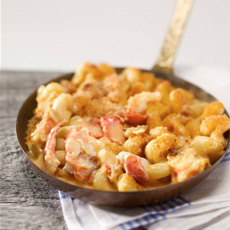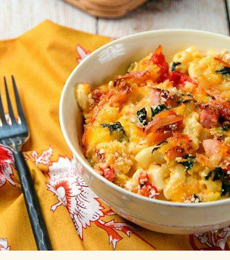TOP PICK OF THE WEEK: Cracker Barrel, The Best Boxed Mac & Cheese
|
Why do so many American households make macaroni and cheese? It’s easy, cheap, fast (9 minutes!) comfort food—at least in modern packaged form. But in the many centuries before boxed mac & cheese, it was as laborious as most other cooking. THE HISTORY OF MACARONI & CHEESE The first written known record of pasta and cheese casseroles dates to medieval cookbooks of the 14th century. The first modern recipe for the dish was published in Britain, in Elizabeth Raffald’s 1769 book, The Experienced English Housekeeper. Raffald’s recipe calls for a mornay sauce—a secondary mother sauce that’s a béchamel sauce with cheese—in this case, cheddar cheese. The sauce is mixed with cooked macaroni, sprinkled with parmesan, and baked until golden. The recipe from scratch requires cooked macaroni (now referred to by its Italian name, pasta); plus milk, butter and flour and cheese to make the cheddar or parmesan sauce. Almost a century later, in 1861, the popular Victorian cookbook Mrs. Beeton’s Book of Household Management offered two recipes for the dish, one topped with the bread crumbs still used today. Both books are available in reprints: Just click the links. Thomas Jefferson encountered pasta in Paris while Minister to France (1885 to 1889), and in his travels to Italy. Back in the U.S., he imported both macaroni and parmesan cheese in order to enjoy cheesy macaroni. The first recipe called “macaroni and cheese” was published in the U.S. in 1824, in Mary Randolph’s influential cookbook, The Virginia Housewife. More American “macaroni and cheese” recipes followed, in the 1852 Hand-book of Useful Arts, and the 1861 Godey’s Lady’s Book. By the mid-1880s, midwestern cookbooks included recipes for macaroni and cheese casseroles. Labor-intensive, the dish was enjoyed by the more affluent [source]. Once it became available in dry packaged form in the first half of the 20th century, mac and cheese became affordable to the masses—and thus less interesting to the affluent. Launched in 1937 in the midst of the Great Depression, Kraft Macaroni and Cheese advertised that a family of four could eat for 19¢, the price of a box. Consumers bought eight million boxes in the first year [source]. A whopping 50 million boxes were sold during World War II, when meat and dairy were in short supply, and one food ration stamp could be exchanged for two boxes of macaroni and cheese. Today, the original packaged form is joined by frozen heat-and-eat versions and cheddar cheese sauce is sold in jars. The dish can be cooked on the stovetop, in the oven or in a microwave. In the United States, July 14th is National Macaroni and Cheese Day. Now that we’re up to date… Up-front disclosure: We’re really picky about our food, and have never enjoyed powdered cheese sauce. Our mom made mac and cheese from scratch, grating cheddar, gruyère or parmesan into her béchamel. She used bricks Cracker Barrel cheddar, her brand of choice. Back then, specialty cheese stores were few and far between; and even today, it’s not easy for many people to find the finest farmhouse (artisan) cheddars (and if you found them, the best use would not be grated into a cheese sauce). So we were more than interested to see what Cracker Barrel would present as a packaged mac and cheese. It’s the cheese that makes the biggest difference in preparations, and Cracker Barrel does not disappoint. Its cheese sauce is not mixed from powder, but is ready to eat, squeezed from a package onto the cooked elbow macaroni. Smooth, creamy and full of flavor, it has a distinctively superior taste, creating what you’d expect from a casual restaurant instead of a boxed product. |
|
|
|
And while it comes in a box, Cracker Barrel is not meant to compete with other boxed mac and cheese (Kraft owns Cracker Barrel as well as the number-one brand, Kraft Macaroni & Cheese) but with prepared dishes from the refrigerated section of the grocery store, and with restaurant dishes. (Kraft, which owns the Cracker Barrel trademark, has no relation to the Cracker Barrel Old Country Store.) People with sophisticated palates will notice the quality. Yet, the price is not much more than other boxed meals. There are four varieties of Cracker Barrel Macaroni and Cheese, featuring different cheese options: No: You can use any pasta. Elbow macaroni most likely became the standard because it was easy for children to eat with a spoon. We heard one of our favorite chefs—Gordon Ramsay—chew out a chef on TV for making mac and cheese with penne, insisting that it must be made with elbows. Not so, chef!
|
||







